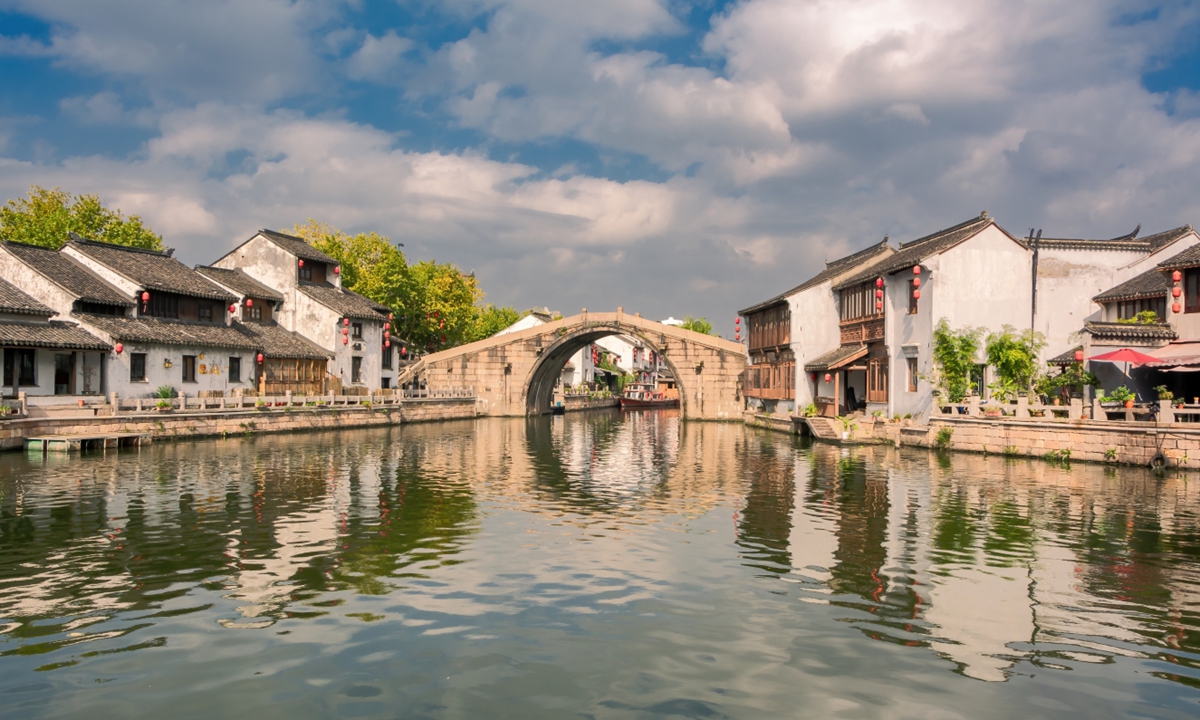
Scenery along the Grand Canal in Wuxi, Jiangsu Province Photo: VCG
The written history of Wuxi, East China's Jiangsu Province, can be traced back to over 3,000 years ago in the late Shang Dynasty (c.1600BC-1046BC). The Wuxi section of the Grand Canal played a distinctive and significant role in the evolution of the UNESCO world heritage site.
Stretching 40.8 kilometers in total, the Wuxi canal system dates back to the Spring and Autumn Period (770BC-476BC) and reached its pinnacle during the Ming (1368-1644) and Qing (1644-1911) dynasties. Once the economic lifeline of ancient Wuxi, the canal has now transformed into a vibrant nightlife hub, attracting young revelers eager to embrace the city's after-dark scene.
Spanning approximately 6 kilometers, the urban section of the canal in Wuxi begins at the iconic Wu Bridge in the north of the city, meandering through several landmarks, before culminating at the picturesque Qingming Bridge in the south of the city.
This section stands as a testament to meticulous revitalization efforts: Along the canal's banks, preserved in their original splendor, stand a myriad of architectural treasures, serving as the backdrop for an eclectic array of establishments. Here, one can traverse a landscape dotted with quaint bars, innovative cultural hubs housed within renovated old factories, and trendy boutiques showcasing the latest in artistic expression.
Since its successful inscription as a UNESCO World Heritage Site in 2014, efforts to protect and preserve the Grand Canal have continued unabated. In early 2023, six areas along the Grand Canal, including Beijing, Shandong, Jiangsu, and Henan, announced plans to jointly develop the Grand Canal National Cultural Park.
By the end of the same year, the Beijing Grand Canal Museum opened to the public, offering vivid insights into the historical evolution of the Grand Canal.
But how can a balance be struck between preservation and utilization in the process of revitalizing the ancient Grand Canal and renovating old city areas? And how can connections be established between ancient history and modern architecture? The section of the Wuxi Canal can offer some insights and practical lessons.
Water quality control
Initially constructed as part of China's extensive Grand Canal system, the canal served as a crucial trade route connecting the northern and southern regions of China. Over time, Wuxi emerged as a key node along this bustling water network, fostering economic prosperity and cultural exchange.
Since the Qing Dynasty, Wuxi witnessed a golden age of canal development, marked by the expansion and enhancement of canal infrastructure. The waterway underwent significant upgrades and renovations, facilitating smoother navigation and boosting trade activities. This period also saw the emergence of thriving canal-side communities, bustling with markets, warehouses, and artisan workshops, further solidifying Wuxi's status as a vibrant commercial center.
"To date the canal banks boast over 30 industrial heritage sites, including the flour mill, Huishan clay figure factory, and silk warehouses. It stands as one of the regions in the country with the highest concentration of industrial heritage sites," Xiao Hui, a local guide, told the Global Times.
The transformation of the canal can be traced back to 2007 when the comprehensive renovation of the Wuxi ancient canal project was initiated.
According to Zou Baiqing, President of the Wuxi Urban Development Group, the initial focus was on water environment management. "Ten years ago, the river here was far from clear," said Zou.
In May 2007, a cyanobacterial bloom in Taihu Lake led to a water shutdown, sparking nationwide concern. Wuxi, as the first place to experience the crisis, was thrust into the spotlight. Following the Taihu Lake water crisis that year, dredging and pollution control efforts along the canal officially commenced at nearly the same time.
The scope of the canal renovation included a total length of approximately 10.5 kilometers. The main contents of the renovation project included widening the canal, dredging, repairing the banks, and ecological restoration.
The reshaped space To emphasize the cultural significance of the canal, Wuxi has also undertaken efforts to protect and restore historical landmarks. Additionally, eight cultural theme parks have been created, reshaping the historical spatial framework of the old city area.
Famous attractions along the canal, such as Donglin Academy, the former residence of Qian Zhongshu, and the residence of the literary master Gu Yuxiu, sparkle like radiant pearls, embellishing the picturesque scenery of the ancient Grand Canal in Wuxi.
The transformation of the canal, which runs through the city, involves approximately 600,000 residents in the old city area. Xiao told the Global Times that instead of relocation, residents have been integrated into the canal's renovation process.
Aside from some opting to convert their homes into guesthouses or cafés, a large number of residents still reside within the canal area.
"This is also the most important reason for preserving the original appearance of the ancient canal and maintaining its ecological integrity," Xiao told the Global Times.
For locals in Wuxi, especially those born in the 1970s and 1980s, the site of the old Xigang Steel Plant along the canal holds significant memories of the city's development.
In November 2007, the entire Xigang Steel Plant was relocated, leaving behind the skeletal remains of its factory buildings standing amid the desolate landscape adjacent to the canal, faintly outlining the scale and magnitude of the once-thriving industrial complex.
Starting in 2020, the transformation project of the industrial heritage of Xigang Steel commenced, with the canal serving as its axis. The main structures of the factory buildings were preserved and repurposed, transforming these industrial landmarks into the new Canal Hub, a space for cultural and tourism activities.
"The transformation of the Wuxi canal is the result of multi-party cooperation, and hopefully it will provide some reference for the future development of the Grand Canal's development," Miao Dongdan, director of the local intangible cultural heritage protection center, told the Global Times.